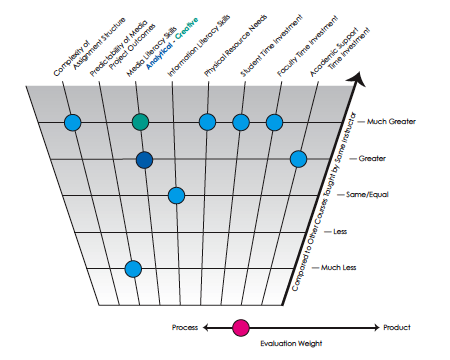Case Study: Collaboration Across the Arts
FA/MUS/PCA 270. Professor Chris Watts, St. Lawrence University
Please provide the course description as it appears in the catalog and the typical enrollment for the course.
The direction of this course is determined largely by the unique combination of students who participate. Students form groups of two or three to work on a collaborative project of their own design reflecting their collective interests. For example, a pair of students may create a multimedia work that draws connections between image and sound. Class sessions feature group critiques of works in progress, study of example works, discussions of relevant aesthetic issues, drawing connections across media and strategies for collaborative work. Typical enrollment: 12
What are the learning goals of the media assignment(s) in the course. If your course assignments contain both analysis and creative production components, describe the learning goals of each.
The primary learning goal of the assignment is that students will learn to work corroboratively to accomplish something they would not likely accomplish alone. Most of the time, students also experience significant gains in new technology skills or deepening of existing ones. As in many courses about art and ideas, however, much of the learning that takes place in this course is not (and should not be) prescribed in advance (see the writings of David L. Miller for more about this if you dare). More than any other course I teach, this one is open to many directions.
What are the relationships of the media assignment(s) to the other aspects of the course?
The assignment is the centerpiece of the course, and most of the work in the course is directly related to the completion of this assignment in some way - historical context, theory, aesthetic sensibilities, skills acquisition, etc.
Describe your assignment design/structure.
Beginning around the third week of the semester, the students begin to form small groups based on their interests and begin to formulate a plan for a multimedia project. Through conversation with one another, the class at large, and the instructor, each group develops an idea for a project and a strategy for executing it. Students receive introductory training for the various technologies that may be necessary, and make decisions (in further consultation with the instructor) about what seems most practical and appropriate. They then proceed with the project, continuing to receive technological assistance as needed and regularly sharing work-in-progress with their classmates. Concurrently, the class works through theoretical material and example work to better contextualize and critique their own projects. As the end of the semester nears, the class mounts a public presentation of their work, also fielding questions from the audience about how they accomplished their work and why.
To what extent does your assignment design address issues of visual/aural literacy?
Because the class is quite small and the assignment so open-ended, discussions of and training in topics related to visual and aural literacies can be provided on a just-in-time basis. Admittedly, this requires reinventing the wheel for every iteration of the course, and places a substantial burden on both the instructor and the students to make sure that crucial pieces are being addressed. The results have often, but not always, been positive.
To what extent does your assignment design address issues of information literacy?
See above
To what extent does your assignment design address issues of technology skills?
See above
What are the resources necessary for your assignment (content/materials, institutional support, equipment)?
It's impossible to know in advance. This is one of the most severe limitations of the project, but the circumstances allow for it (i.e., the instructor is proficient in dozens of digital media software applications and is the faculty director of the facility that supports the course). Not an advisable undertaking for instructors with any reservations about their proficiency with the available technology.
Describe how you evaluated the project outcomes? Did you evaluate process? Outcomes? Both?
Because the assignment is so open-ended, it has proven difficult to develop a generic rubric for assessment. The instructor develops a customized rubric for each of the small teams, with the elements to be evaluated falling in the following broad categories: content, production, rhetorical strategy, group dynamics. Each student receives written comments - some directed toward the group and some toward the individual. Each group member does not necessarily receive an identical grade.
In the end, process is weighed much more heavily than outcome.
Estimate the time invested in the project by you, your students, and academic support staff.
The time investment varies considerably because of the extent to which the projects vary. Faculty and student time commitments likely exceed what they devote to any other single project in the semester; staff time commitments are minimal because of the instructor's relationship to the resources. The staff time commitment would certainly be substantial if this were not the case. Student staff provide basic-level support for these students and others during a scheduled 40-hour window each week.
How many times have you taught this course/assignment? What would you do differently next time?
I have taught this course and assignment 4 times. I continue to look for additional ways to force the projects to come together earlier in the semester, so that we have enough time at the end to reflect on what has taken place and critique both process and outcomes as a group.
What is your level of expertise with respect to media technologies and scholarship?
I consider myself to be an expert in working with media technologies, both in my own work and in the classroom.
Projects for this course were created in St. Lawrence University's NCAT.
